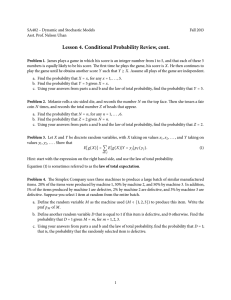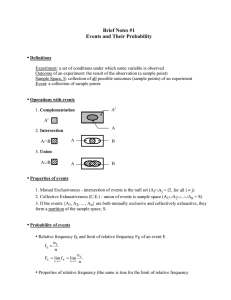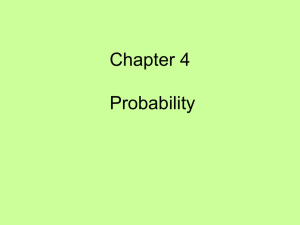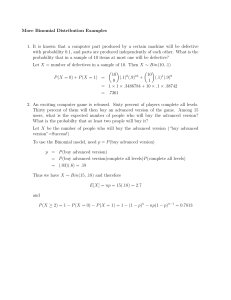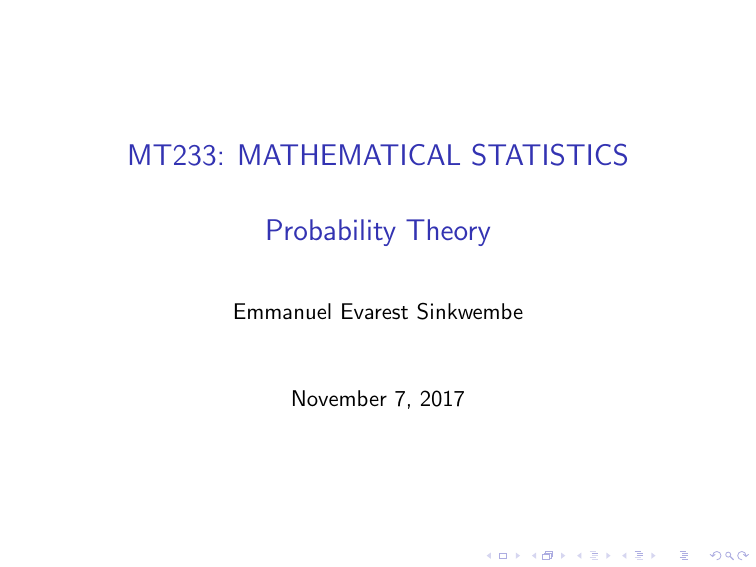
MT233: MATHEMATICAL STATISTICS
Probability Theory
Emmanuel Evarest Sinkwembe
November 7, 2017
Outline
Probability Theory
Introduction
Axiomatic definition of Probability
Conditional Probability
Independent events
Theorem of Total Probability
Baye’s Theorem
Introduction
Probability theory is the study of random or unpredictable
experiment.
Although all possible outcomes of an experiment may be known in
advance, the outcomes of a particular performance of experiment
cannot be predicted owing to a number of unknown causes.
For instance, Although the number of telephone calls received in a
board in a 5 minutes interval is non-negative integer, we cannot
predict exactly the number of calls received in the next 5 minutes.
In such situations we talk of the chance or probability of
occurrence of a particular outcome, which is the quantitative
measure of the likelihood of occurrence of the outcome.
Mathematical Definition of Probability
Let S be the sample space (outcomes assumed to be equally likely)
and A be an event (subset of S) associated with a random
experiment. Then the probability of event A occurring denoted as
P(A), is defined by
P(A) =
n(A)
Number of cases favourable toA
=
.
n(S)
Exhaustive number of cases inS
(1)
For example, the probability of getting an even number in the die
tossing experiment is 0.5, since S = {1, 2, 3, 4, 5, 6}, A = {2, 4, 6},
n(S) = 6 and n(A) = 3.
Statistical Definition of Probability
Let a random experiment be repeated n times and let an event A
occur nA times out of the n trials. The ratio nnA is called the
relative frequency of the event A. As n increases, nnA shows a
tendency to stabilize and approach a constant value, denoted by
P(A) called the probability of an event A, i.e.
P(A) = lim
n→∞
nA
.
n
(2)
For example, if we want to find the probability that a spare part
produced by a machine is defective, we study the record of
defective items produced by the machine over a considered period
of time. If out of 10000 items produced, 500 are defective it is
assumed that the probability of a defective item is 0.05.
Axiomatic Definition of Probability
Let S be the sample space and A be an event associated with a
random experiment. Then the probability of the event A, denoted
by P(A) satisfies the following axioms
(i) 0 ≤ P(A) ≤ 1
(ii) P(S) = 1
(iii) If A is an impossible event, P(A) = 0
(iv) If A and B are mutually exclusive events,
P(A ∪ B) = P(A) + P(B)
(v) If A1 , A2 , · · · , An , · · · are sets of mutually exclusive events,
then
P(A1 ∪A2 ∪· · ·∪An ∪· · · ) = P(A1 )+P(A2 )+· · ·+P(An )+· · ·
Note: A set of events are said to be mutually exclusive if the
occurrence of any one of them excludes the occurrence of the
others, i.e. P(A1 ∩ A2 ∩ · · · ) = 0.
Conditional Probability
Conditional probability of an event B, assuming that the event A
has happened, is denoted by P(B/A) and defined as
P(B/A) =
P(A ∩ B)
, P(A) 6= 0.
P(A)
(3)
For example, when a fair dice is tossed, the conditional probability
of getting 1, given that an odd number has been obtained, is given
as follows: S = {1, 2, 3, 3, 4, 5, 6}, A = {1, 3, 5}, B = {1}. Then
1/6
1
P(B/A) = P(A∩B)
P(A) = 1/2 = 3 .
Independent Events
A set of events is said to be independent if the occurrence any one
of them does not depend on the occurrence/non-occurrence of the
others.
If two events A and B are independent, then
(i) P(B/A) = P(B),
(ii) P(A ∩ B) = P(A) × P(B), this can be extended to any
number of independent events
(iii) events Ā and B (similarly A and B̄ ) are also independent,
(iv) events Ā and B̄ are also independent
Example
Two defective tubes get mixed up with two good ones. The tubes
are tested, one by one, until both defective are found. What is the
probability that the last defective tube is obtained on (i) the
second test, (ii) third test and (iii) the fourth test?
Answer
Let D represent defective and N represent non-defective tube.
(i )P(Second D in the second test)
= P(D in the first test and D in the second test)
= P(D1 ∩ D2 )
= P(D1 ) × P(D2 ), (by independence)
1
2 1
= × =
4 3
6
(ii)P(Second D in the third test) = P(D1 ∩ N2 ∩ D3 or N1 ∩ D2 ∩ D3 )
= P(D1 ∩ N2 ∩ T3 ) + P(N1 ∩ D2 ∩ T3 )
2 2 1 2 2 1
= × × + × ×
4 3 2 4 3 2
1
= .
3
(iii)P(Second D in the fourth test)
= P(D1 ∩ N2 ∩ N3 ∩ D4 or N1 ∩ D2 ∩ N3 ∩ D4 or N1 ∩ N2 ∩ D3 ∩ D4 )
= P(D1 ∩ N2 ∩ N3 ∩ D4 ) + P(N1 ∩ D2 ∩ N3 ∩ D4 ) + P(N1 ∩ N2 ∩ D3 ∩ D4 )
2 2 1
2 2 1
1
2 2 1
= × × ×1+ × × ×1+ × × ×1= .
4 3 2
4 3 2
4 3 2
2
Theorem of Total Probability
If B1 , B2 , · · · , Bn is a set of exhaustive and mutually exclusive
events, and A is another event associated with (caused by) Bi , then
P(A) =
n
X
P(Bi )P(A/Bi )
(4)
i =1
Proof
The inner circle represent the event A, A can occur along with (due
to ) B1 , B2 , · · · , Bn that are exhaustive and mutually exclusive.
AB1 , AB2 , · · · , ABn are also mutually exclusive,
It follows that A = AB1 +AB2 + · · · + ABn
n
P
P
P
ABi = P(ABi ) =
P(Bi )P(A/Bi ).
Thus, P(A) = P
i
i
i =1
Baye’s Theorem
If B1 , B2 , · · · , Bn is a set of exhaustive and mutually exclusive
events associated with a random experiment and A is another
event associated with (or caused by) Bi , then
P(Bi /A) =
P(Bi ) × P(A/Bi )
, i = 1, 2, . . . , n.
n
P
P(Bi ) × P(A/Bi )
i =1
Proof
P(Bi ∩ A) = P(Bi ) × P(A/Bi ) = P(A) × P(Bi /A)
P(Bi ) × P(A/Bi )
∴ P(Bi /A) =
P(A)
P(Bi ) × P(A/Bi )
, i = 1, 2, . . . , n
= n
P
P(Bi ) × P(A/Bi )
i =1
(5)
Example
A bolt is manufactured by three machines, A, B and C . A turns
out as many items as B, and machines B and C produce equal
number of items. 2% of bolts produced by A and B are defective
and 4% of the bolts produced by C are defective. All bolts are put
into one stock pile and one is chosen from this pile. (i) What is
the probability that it is defective? (ii) What is the probability that
the chosen bolt was manufactured by machine A given that it is
defective?
Answer:
Let A = the event in which the item has been produced by
machine A, likewise for B and C .
Let D = the event of the item being defective.
P(A) =
1
1
2
, P(B) = P(C ) = , P(D/A) =
= P(D/B) and
2
4
100
P(D/C ) = 4/100.
(i) By theorem of total probability,
P(D) = P(A) × P(D/A) + P(B) × P(D/B) + P(C ) × P(D/C )
2
1
2
1
4
1
1
+ ×
+ ×
=
= ×
2 100 4 100 4 100
40
(ii) By Baye’s theorem
P(A) × P(D/A)
P(A) × P(D/A) + P(B) × P(D/B) + P(C ) × P(D/C )
= (0.5 × 0.02)/0.025 = 0.4
P(A/D) =
